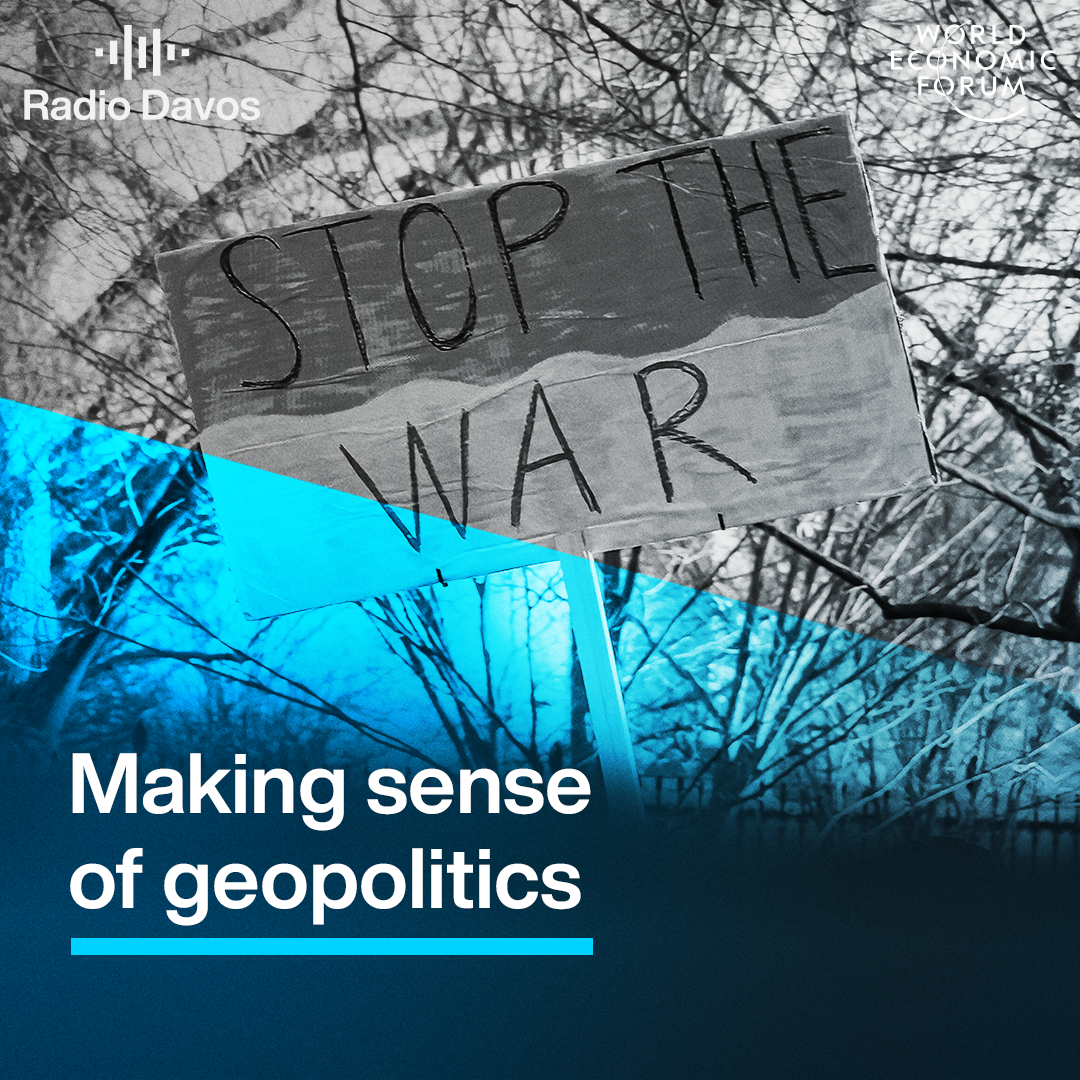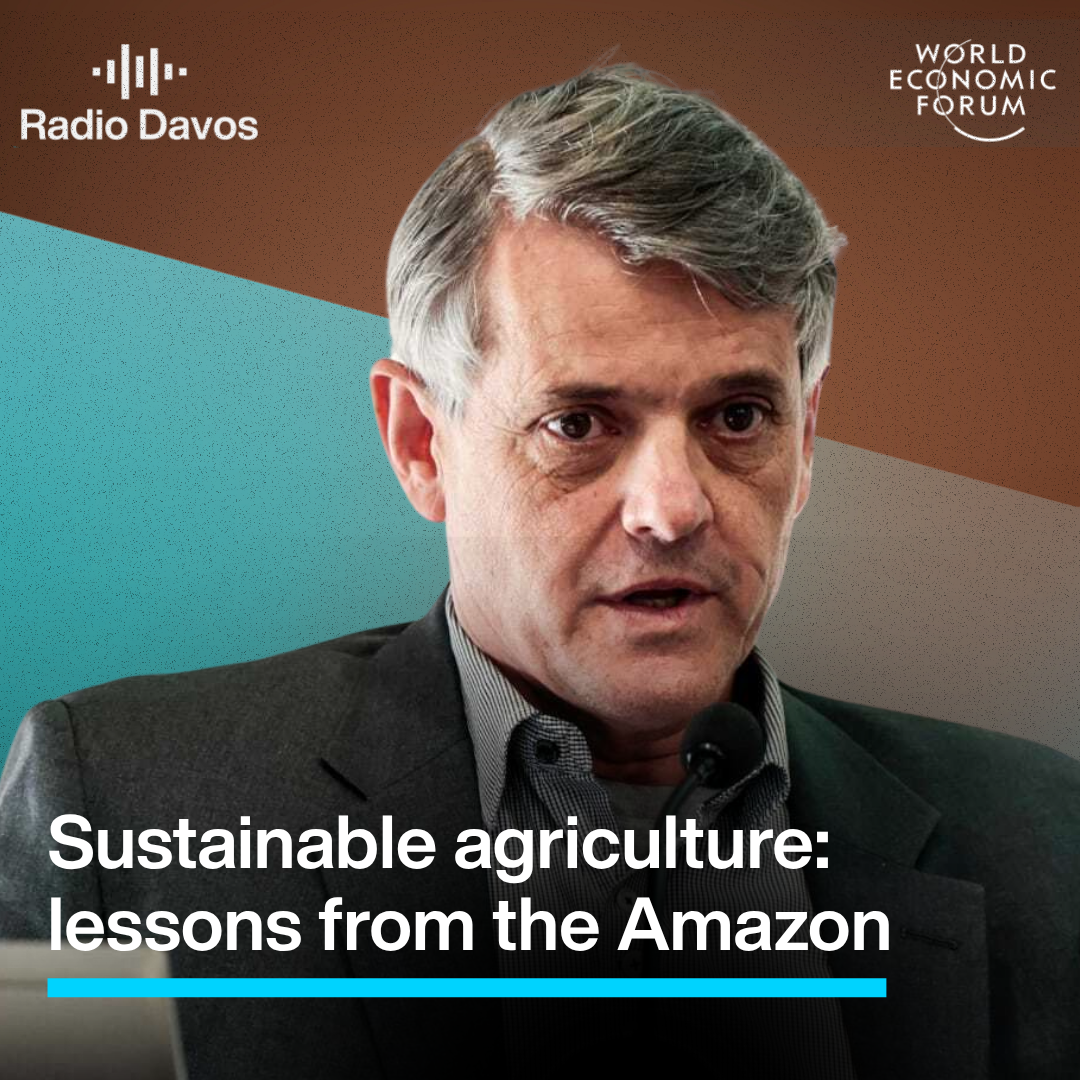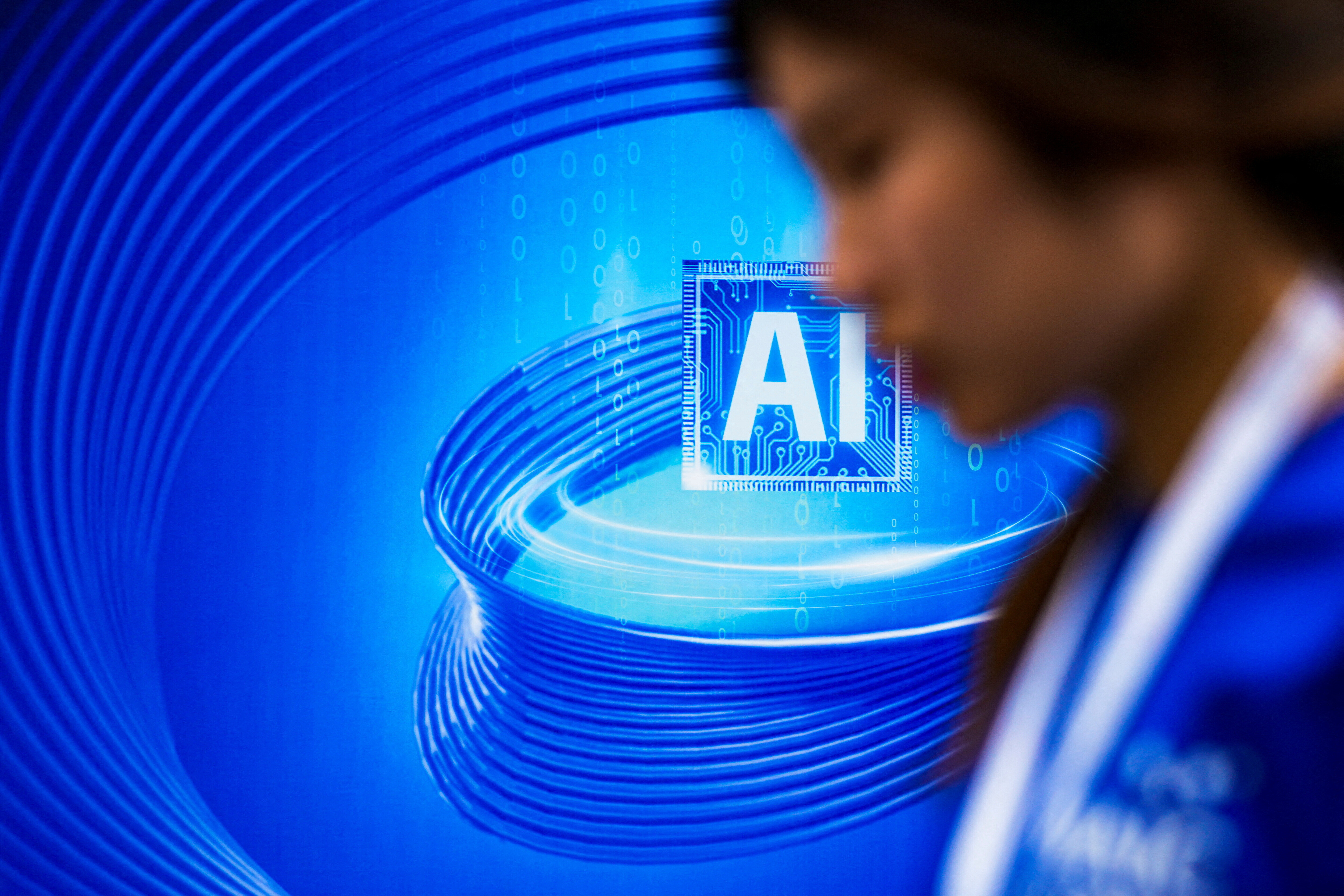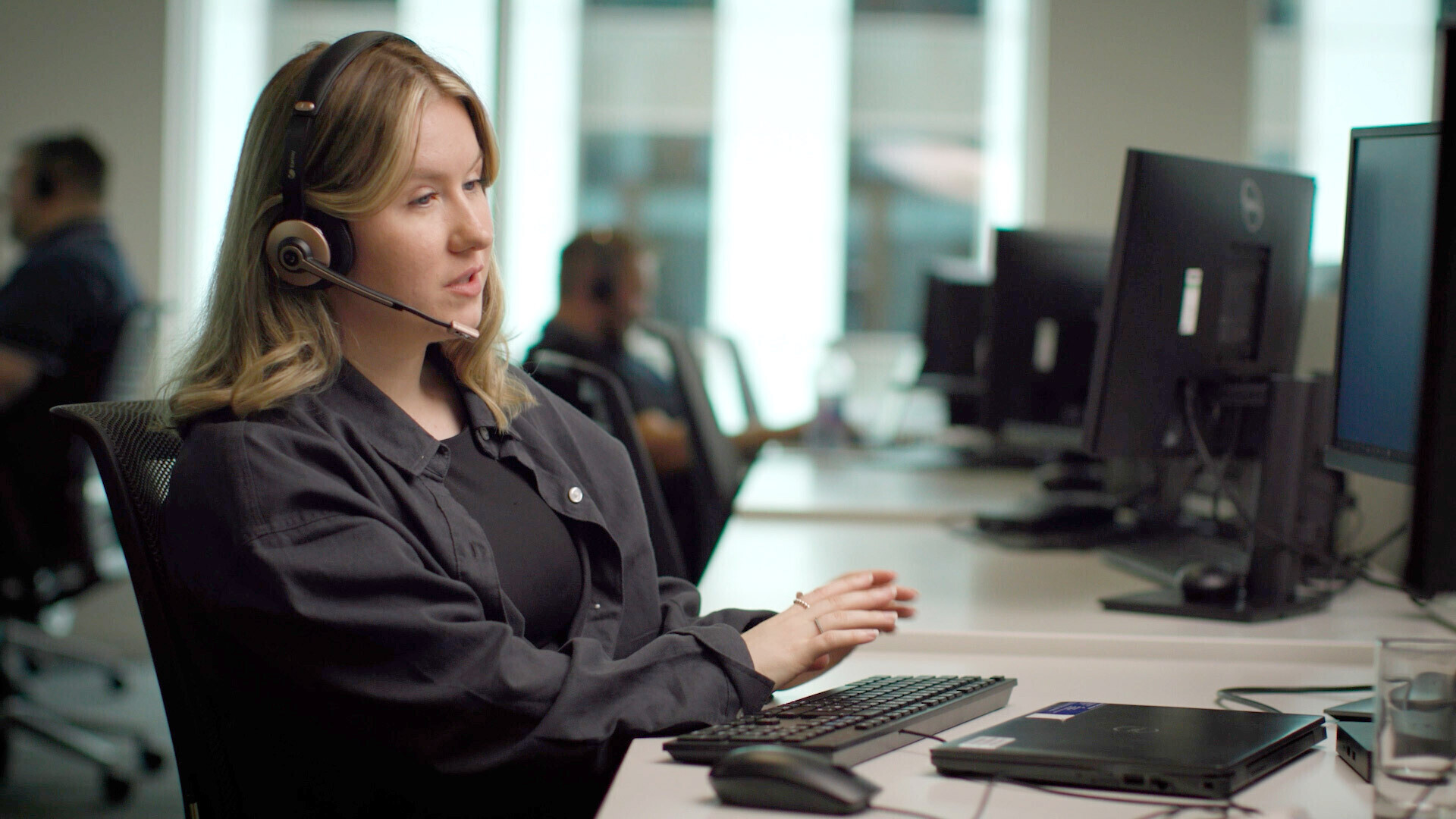Beyond the hype, how industries are deploying AI at the heart of their operations
Scroll down for full podcast transcript - click the ‘Show more’ arrow
There was the hype, then the testing, now companies are deploying artificial intelligence at the heart of their operations. We ask one of the world's most prominent AI scientists for his advice for companies, and hear how Siemens is creating the 'brains' to run the factories of the future.
Guests:
播客文字稿
Anderw Ng, managing general partner, AI FUNDS and founder of DeepLearning.AI: For most businesses looking to create value, I would say look through the applications and what are the unique things you can build with AI that were not possible just 1 or 2 years ago.
Robin Pomeroy, host, Radio Davos: Welcome to Radio Davos, the podcast from the World Economic Forum that looks at the biggest challenges and how we might solve them. This week we are looking at how businesses are deploying artificial intelligence.
Cathy Li, head, AI, data and metaverse, World Economic Forum: We are seeing a real shift from companies experimenting with AI in small pilots to actually scaling it across their businesses.
Robin Pomeroy: The World Economic Forum has looked at how AI is being used across a wide range of sectors - and has published the findings to help companies deploy the technology safely, responsibly and profitably.
Kiva Allgood, head, Centre for Advanced Manufacturing, World Economic Forum: If you walk in a factory that's truly advanced today, you'll have autonomously guided vehicles everywhere, delivering different pieces just in time for when that specific part is needed. Those are all great examples of how they're using machine learning AI and AI agents on the factory floor.
Robin Pomeroy: We hear from one of the world’s most influential AI researchers and from Siemens, a company that makes the ‘brains’ for other manufacturers to use AI in their factories.
Cedrik Neike, CEO, Digital Industries, Siemens: The advantage you have ongoing digital in AI is that you can learn from your mistakes way, way faster. You run scenarios, not one or 10 or 100 times, but thousands or millions of times.
Robin Pomeroy: I’m Robin Pomeroy at the World Economic Forum, and with this look at how AI is changing industry and everyone in it.
Cedrik Neike: AI was the domain of the nerds in the basements which would come up and look at a problem and go back and calculate it. Now everybody can. I mean, and that makes a huge difference if you put it in the hands of everybody.
Robin Pomeroy: This is Radio Davos.
Welcome to Radio Davos where we are once again talking about artificial intelligence and I'm joined at the start of this episode by Cathy Li. Cathy, how are you?
Cathy Li: I'm good, how're you Robin?
Robin Pomeroy: Very well, thank you. Remind us Cathy what your important job is at the World Economic Forum.
Cathy Li: I head the AI data and metaverse work at the World Economic Forum.
Robin Pomeroy: We're going to be talking about these white papers that you published. Most of them were published in Davos, I think, in the Annual Meeting. This series is called AI in Action Beyond Experimentation to Transform Industry. Tell us what, you know, in a nutshell, what these papers set out to do.
Cathy Li: In January, we launched this whole series, as you just mentioned, which takes a deep dive into how AI is transforming different industries. AI is evolving at a incredible pace and with so much changing. We wanted to capture where things stand today while also keeping an eye on what's next. This is a 10-paper series developed with Accenture, BCG, McKinsey, and the University of Oxford. covering a mix of broad industry trends and more focused deep dives into specific sectors and regions.
Robin Pomeroy: Right, so there are other papers in this series covering, could you give us an idea of what they cover?
Cathy Li: Healthcare, financial services, media, transport, advanced manufacturing, and critical topics such as energy, cybersecurity, and AI's industry development in China.
Robin Pomeroy: Industries have been using artificial intelligence for many many years. It's not as if it's this brand new technology. But for most of us kind of civilians it was the launch of ChatGPT at the end of 2022 that really brought it to our attention, this amazing thing. And there was maybe a hype bubble for, you know, the rest of that year, 2023, and now I think everyone, industries and just normal people who have access to anything like ChatGPT or any of those other things, many of which are free, what to actually do with this.
So you've got big, big companies who maybe have been using it before. And these papers, I suppose, are designed to help them get an idea of what other people are doing with this evolving technology.
Cathy Li: You're absolutely right. We understand, we know that we're still in the middle of this AI hype cycle, but what's really exciting is that we are seeing a real shift from companies experimenting with AI in small pilots to actually scaling it across their businesses.
The reports highlight how AI is no longer just about efficiency, it's becoming a core driver for growth and transformation. And some of the numbers really stand out. Companies that lead in AI adoption are already outperforming their peers by 15% in revenue generation. It's a figure that's projected to more than double by 2026. And this expected revenue growth could contribute some figure between 7.6 to 17.9 trillion dollars to the global economy by 2038. with the upper end of the range achieved through people-centric solutions.
Robin Pomeroy: Tell us about this first paper then of these 10. It's already out there. People can get it on our website. It's the cross industry one, kind of summarising everything. Tell us some of the highlights from that.
Cathy Li: The paper was developed with Accenture. It takes a closer look at how AI is moving beyond the testing phase and into real world impact across industries. So some of the figures that I just quoted earlier really demonstrate that transformative impact of AI.
It also dives into what it takes to make AI transformation work. Things like having the right digital infrastructure, strong cyber security. and the workforce that's ready to work with AI. These are the areas that will determine which companies really get ahead.
Robin Pomeroy: So it's beyond hype, and it's getting beyond experimentation. Companies are really implementing this. Later in the programme, I'll be talking with our colleague, Kiva Allgood who heads the Advanced Manufacturing Centre at the World Economic Forum, and we'll be hearing from someone from the engineering company Siemens about how that huge company is using, he'll be giving us examples of what they're doing on the ground with artificial intelligence.
But before that, we have another interview. A colleague of mine spoke to Andrew Ng. Could you tell us something about him? He's been on Radio Davos before. Remind us who Andrew Ng is and what he's going to talk about.
Cathy Li: Andrew Ng, we work with him very closely. He's a legendary AI researcher, and he runs AI FUND now. He also is part of numerous AI startups, including Coursera, which is a household name.
Andrew Ng goes into how AI is evolving, not just in terms of technical advancements, but in how businesses are shifting from theoretical discussions to real, practical applications. He highlights how AI has been using industries beyond tech, from optimising pricing strategies to streamlining legal document processing and even facilitating cross-border trade.
He also talks about a key shift happening right now, moving beyond the AI hype and focusing on tangible business value. One of his most interesting points is that AI's biggest impact isn't just in the foundation models we hear so much about. but in the applications built on top of them.
Another important takeaway is the growing need for AI literacy across all professions. Andrew makes a strong case for why simply being an AI user isn't enough anymore. He believes that the professionals who develop a deeper technical understanding will be the one who truly maximise AI's potential in their fields.
It's a really insightful discussion, and I'm super excited for listeners to dive into it.
Robin Pomeroy: This is Andrew Ng talking to my colleague Anna-Bruce Lockhart in Davos in January.
Andrew Ng
Andrew Ng: Andrew Ng, managing general partner of AI FUNDS and founder of DeepLearning.AI.
Anna Bruce-Lockhart: Here at Davos, you recently spoke about artificial general intelligence. How do you see AI evolving to better understand and emulate human reasoning?
Andrew Ng: There's a love excitement about it. And as AI improves this reasoning ability, this set of tasks that AI is able to do is expanding. And the reasons it's exciting is because this also expands the set that applications that are now possible by building on top of AI.
I think intelligence in isolation is not that useful. It's when you find an application such as, can we use this to speed up cross-border trade by improving compliance? Or can we use this to drive pricing on analytics? Or could we use this to help process legal documents?
It's those applications where the value is. And so as AI becomes more intelligent and more able to generate sensible responses, the effectiveness with which you can build these applications also grows.
Anna Bruce-Lockhart: So which industries you believe are under-utilizing AI?
Andrew Ng: AI is a general purpose technology, meaning it's useful not just for 1 or 2 things, but for many different things. And I think adoption of AI has been progressing across all industries, but industries that are more digital are probably ahead. So tech is clearly very digital, embracing AI. I think finance, financial services, maybe healthcare industry a little bit more digital.
In contrast, industries such as natural resource extraction, it turns out that in the last decade they've become quite digital as well. But then maybe the I.T. staffing and their skill set isn't as advanced as financial services.
But I think compared to 10 years ago, all industries are much more digital than they have been. So I feel like there is adoption of AI pretty much happening across all sectors.
Anna Bruce-Lockhart: How can businesses use AI to innovate?
Andrew Ng: There's so much excitement about AI, but where are the biggest opportunities?
This is what I think of as the AI stack.
At the lowest level is semiconductors. And then the cloud companies and then the large AI model trainers or the foundation model companies.
And it turns out there's a lot of excitement buzz about these technology companies. And that's fine. Nothing wrong with that. This is exciting. Almost by definition, though, there's another layer of the AI stack that's going to be even more valuable, which is the applications we build on top, because frankly, we need the applications that generate even more revenue so they can afford to pay these technology providers that the media writes about so much.
So for most businesses looking to create value, I would say look for the applications and what are the unique things you can build with AI that were not possible just 1 or 2 years ago.
The conversations at WEF this year were very encouraging. Last year there was a lot of hype and unnecessary fears about will AI kill us all - the answer's no, by the way,
I think this year the hype is still a little bit there, but it's died down substantially. But I find myself seeing a lot more business implementation conversations where businesses will be excited about, you know, AGI and intelligence and all of these things, but then they'll sit and say, okay, great, now let's figure out concretely what work needs to be done in order to drive a valuable business use case.
This year's WEF had so many businesses looking concretely into what to do that I have a prediction for next year's WEF, which is that we'll be back and we'll hear a lot more success stories from many businesses. And so that feels really good to me.
Because AI is a general purpose, technology, it's applicable to so many different things. I'm seeing it be used, for example, to process tricky legal documents and get to conclusions faster or to file paperwork to smooth out cross-border trades or, one of the teams I'm working with uses it for pricing analytics, and it turns out that when you get the pricing right, you can improve profitability by 20-30%, you know, very rapidly.
So I'm seeing more stories of concrete use cases with business ROI. And this is encouraging because this is a very welcome shift from some of the, you know, hype that had been around AI for the past couple of years.
Anna Bruce-Lockhart: So how do smaller businesses leverage AI to become more competitive?
Andrew Ng: Some of the hype around AI has been on how expensive AI is. And it turns out that if you want to build a cutting edge large AI model, that is expensive, plan to spend, you know, $2 billion for that or something.
But it turns out that for a lot of applications, because someone else has spent billions of dollars training these AI models, that you can now access for, you know, dollars or cents, it's now actually very capital efficient to innovate and try new ideas and build these new things.
My team at AI Fund budgets 55,000 USD to get a working prototype to test out if an idea is something we should double down on.
And so for small businesses, and large businesses, I think figuring out the right corporate innovation process to build prototypes, experiment and go for the upside will be important for this experience.
Anna Bruce-Lockhart: You've long been an advocate for democratizing AI. What are the biggest barriers to achieving this and how can they be overcome?
Andrew Ng: One of the most important skills for anyone in the future is the ability to get a computer to do exactly what you want it to do, because computers are becoming more powerful. And not just software engineers, but really all knowledge workers, maybe even non knowledge workers, we'll be much more powerful if we can bend computers to our will.
But it turns out that to get that deeper understanding, to have the language or the ways to manage your computers, takes new training. So Coursera, DeepLearning.AI, other organizations, are working hard to provide this type of upskilling.
And to anyone with kids. I'm often asked, should I still get my kids to learn to code? My answer's yes, get them to learn to code, because I think that deeper understanding of how computers work will be important foundation for not just the software engineers, but really all job roles in the future.
Today I can't imagine hiring a marketer or finance person that doesn't know how to search the web because this is a new capability that came up, makes everyone more productive. I think we are soon approaching the point, I think we're actually already at the point, I can't imagine today hiring a marketer that doesn't know how to use AI deeply. And I think in the future I won't hire any marketer that doesn't know, at a deeper level, almost at the code level, how they make use of AI.
One thing I've been curious about in tech with this concept of the 10x programmer, where some programmers are maybe ten times better at getting computers to do things than other programmers. As more job functions become more technical through the use of AI, I actually wonder if AI creates more opportunities for that to be a lot more 10x marketers and 10x recruiters and 10x finance people, because there will be people that will master AI and be able to use it the way that now software engineers do and just get a lot more done than others in the same job function that don't know how to leverage and manage this amazing tool.
Anna Bruce-Lockhart: So where is the line that just between, obviously most people, even people who are interested in training up in AI, they tend to just use it as a kind of user. So they are using the language models that somebody else has built. So is that enough in this day and age just to sort of know how to use will be available apps, be clever about that or do you have to go deeper and really know how to construct them?
Andrew Ng: It is a great first step to learn to be a user of AI, to know how to prompt AI models on the internet well. But what I'm seeing is for the most sophisticated tasks, people that have a deeper understanding of computers would really go much further.
And at this moment in time, learning just a little bit about how to code gives you that deeper knowledge to be much more effective.
It turns out that with AI-assisted coding, a little bit of learning goes a long way. And I know that some people are saying AI will do all the coding, you don't need to code anymore. I think that's wrong. I think the point is not coding is learning that deeper understanding of how to get the computer to do what you want.
A few years ago there was an eye-opening moment for me when I was was working with a collaborator on using AI to generate pictures for background images for a course I was teaching. And I was writing problems and I got pictures that looked so-so. But one of my collaborators had studied art history. He had the right language to tell a computer what images he wanted to generate, and we ended up using all of his images and none of mine.
And I think that in getting computers to do our business tasks as well as different job functions, I've seen the same thing, that people with that deeper understanding with the right language and the right mindset are much better able to direct computers to help us with various functions, various knowledge work functions. So I think this is a good time to learn to code.
Anna Bruce-Lockhart: If you could change one misconception the public has about it, what would it be?
Andrew Ng: Over the last couple of years, there's been a lot of hype about some parts of AI that frankly were driven, I think, by the PR goals of years, sometimes specific AI companies trying to make a big deal or something or fundraise or whatever. And this has been remarkably effective at steering society's attention. It is exciting, AI technology and companies. But what I think we pay not enough attention is that the application layer, because the real value of AI, most of the value, isn't the technology, its' what applications we can build on top of that.
So to most people and businesses, I would say, you know, pay attention, the hype is entertaining, it's great, it's exciting. But focus also on thinking through what the applications you can build.
And for most businesses is not as simple as dumping everything into a large language model on the internet. You have to identify the unique use case and think through the workflow, sometimes we call these agentic work flows, needed to realize a specific valuable business application.
Robin Pomeroy: That was Andrew Ng talking to us in Davos in January. Still got Cathy Li with us, Cathy?
Cathy Li: I wanted to also add that the Forum now is seeking the most groundbreaking AI-enabled business transformation case studies and solutions across industries and functions.
We just opened up the MINDS programme last week. MINDS stands for Meaningful, Intelligent, and Novel, Deployable AI Solutions. So please do apply and be part of the next generation AI transformation business cases.
Robin Pomeroy: So what's that, so if I'm a company and I'm doing something really interesting in AI, I can get involved in this?
Cathy Li: Absolutely. Please be involved and you might get recognised and, most importantly, there will be a lot you can learn from your peers.
Robin Pomeroy: That's the first half of this. In the second half of the episode, we'll be talking about advanced manufacturing, high-tech factories. But for now, Cathy Li, thanks very much for joining us on Radio Davos.
Cathy Li: Thank you, Robin.
Robin Pomeroy: To continue our exploration of how artificial intelligence is being adopted and applied in industry, I'm joined by my colleague Kiva Allgood. Hi, Kiva, how are you?
Kiva Allgood: Hi Robin, I'm doing well today.
Robin Pomeroy: Remind us what is it you do at the World Economic Forum.
Kiva Allgood: Yes, I lead the Centre for Advanced Manufacturing and we are entirely focused on really unifying the global manufacturing supply chain leaders across all industries. So we've got 22 different industries that we work with to really share best practises, spark innovation, and scale impact.
Robin Pomeroy: So it's advanced manufacturing, and you're looking at ways companies are making stuff, factories of the future, this kind of thing. So AI must be an important thing for them right now.
Kiva Allgood: Oh it is, I mean I'd say we partner with anybody who makes or moves things. So the laptop that you're working on, the speakers we're speaking into, these are all manufacturered and they have a full supply chain and value chain. They have been learning and leveraging AI for decades, so in different forms. So if you think about machine learning, the beginning parts of using technology to create automation, manufacturers are really at the forefront of that and AI is no different.
Robin Pomeroy: And you created this report, one of this series of reports that we're looking at in this podcast, Frontier Technologies in Industrial Operations. Can you pick out some highlights maybe that people might be interested in how AI is being applied now and in the near term?
Kiva Allgood: You bet, I mean, part of my role, we also run a programme called the Global Lighthouse Network, which is a peer-based awards programme. Think of it like a Michelin star. We, you know, site supply, and they have to supply at least 18 months worth of performance improvement data across five different dimensions. And really, it's the best of the best. And this is a peer group award. And so we use a lot of that insight and data. This programme started over six years ago.
When we first launched the Global Lighthouse Network, we had a very small number of use cases and applications of AI. Today, we have almost 80.
So 80% of the people who are now considered the best of the best as far as manufacturing and supply chain practises are using AI in some way. A lot of them are using a generative AI.
And so I think the word of the day is AI, but really what it comes down to is process improvement. How are you helping the factory or the logistics save money, make money, or come up with a new business model? AI plays a really interesting role in that.
But they also have learned over the last bit that you need to bring the floor, the people who work there, on that journey as well. So a lot of the use cases we're highlighting around AI and AI agents in a different type, is based off the fact that you've got to collect the insights and the intelligence. from the people on the factory floor, and embed those into these different types of agents in order to see the biggest impact in process improvement.
Robin Pomeroy: Are there any examples you could give us kind of a real world of how AI has been deployed in a way that has really transformed the way...?
Kiva Allgood: I mean, there's so many examples, actually. The white paper does an amazing job of outlining those.
And I get to walk into a lot of these factories and I get see how they're really demonstrating best practises. There is one factory I had the opportunity, and they're using AI in their aluminium stamping process. To really, really get the right strength out of the aluminium, you have to manage the temperature of the water. So they use these different AI agents and tools to understand how is that aluminium being processed by every millisecond really, to be able to control the water so that they get the best quality product at the end.
We've seen where you've got logistics and supply chain managers, where it would have taken them probably a month, to run a whole bunch of different scenarios, say nine different ways, of thinking about procurement and supply chains. They can do that in minutes today.
So I think there's no end. I mean, if you walk in a factory that's truly advanced today, you'll have autonomously guided vehicles everywhere. They'll be delivering different pieces, parts, just in time for when that specific part is needed.
Those are all great examples of how they're using machine learning AI and AI agents on the factory floor.
Robin Pomeroy: Is it easy for companies to adopt these technologies? Are there some companies you speak to, like, I feel we should be doing more with AI, but we're not really sure where to go, which parts of our operations we should be developing with AI? What are the barriers that some companies may be finding difficult?
Kiva Allgood: Typically a barrier is data, right? Do you have the data in order to create a model? And sometimes that's in someone's brain. They know how the machine, and when it starts to vibrate like this, they need to do this. That is also critical. So I'd say data tends to be one of the areas. That's where you see a lot of advancement in spaces like financial services or insurance or taxes. You've collected that data for decades, right? When you think about logistics on a factory floor, you have lots of process inputs. You have lots data. Often, it's not clean. It is from lots of different types of systems. It has different types taxonomy, so you have to kind of collect it and clean it before you can take action from it.
Robin Pomeroy: So I interviewed in Davos, Cedrik Neike, CEO of Digital Industries at Siemens, big company involved in making big machines, often involved in manufacturing, and he's in the digital side of that, and he says at the start of the interview, we make the brains that will run factories in some cases. Can you tell us something about him?
Kiva Allgood: Yes, I'd say he's a pioneer in the industry. I think he's, and Siemens in general, they've really leaned into the concept of how do we ensure that we, as an industry, can collectively move forward, especially when you think about sustainability.
You can't improve saving water and electricity and doing things with less natural resources if you don't have that brain and you don't have that insight. And that's something Siemens has firmly, firmly leaned into, Cedrik as well.
I think they've challenged their peer group to elevate and think more as an open ecosystem and to evolve, to get to that next level of really understanding human-machines and how they interact on a factory floor.
But 100%, that kind of intelligent manufacturing or say a software-defined factory, that's here today, they exist. And a lot of that is due to the fact that Cedrik and companies like Siemens have really thought about what is the industry going to be like 10, 15 years from now, and they've really aimed for that and leaned forward.
Robin Pomeroy: Well, let's hear from Cedrik now.
Cedrik Neike
Cedrik Neike: My name is Cedrk Neike. I'm a board member at Siemens and I'm the CEO of the Digital Industry, part of Siemens.
Robin Pomeroy: What is the digital industry part of Siemens?
Cedrik Neike: So we basically build the software and also the automation for most industries out there. And this starts really on the software side. Imagine you dream up a new idea so you can sort of build it in software, you can simulate it, and then you make sure that you can build it. And then once you put it into automation, it actually gets done. These are the two things which we do, the brain of the machines. Siemens builds a third of them in the world.
Robin Pomeroy: So let me try to understand that. These are other companies that want a brain, as you call it, and they come to you to get that?
Cedrik Neike: So you want to build a car. If you build a car, we will have the software to design the car, to test it, if you crash it against the wall, to actually make sure it's getting produced. So we do that for a car and then we would build the factory, actually building the car to help build the brains behind that factory.
We would do this also for pharmaceuticals. We would do this for pizzas. We would do this. I mean, imagine anything which needs to get built, we would be in that process.
Robin Pomeroy: That sounds like an area where you'll have been using artificial intelligence for a long time, this is nothing new to you.
Cedrik Neike: So, yes, we've been looking at AI for a long, long time. I think we started with some of the base concepts in the 70s, and I think Siemens has more than 3,700 patents in AI and a lot of them are applied to industry.
Robin Pomeroy: What's changed recently then with this generative AI explosion?
Cedrik Neike: It's a bit like the internet, right? I mean, the internet had existed for a long time and then, boom, the browser came up and the internet sort of really sort of got on its feet.
And the same thing with generative AI. AI has been existing for a long, long time, but gen-AI made it much easier to train it. Where we used specialists and months to train AI onto the shop floor. We can now do it in days or even hours, and that's a huge difference. It's the ease of adoption has increased dramatically and of course therefore also the impact.
Robin Pomeroy: It means that people with ideas but not necessarily trained in software engineering can start working on that thing straight away.
Cedrik Neike: Yes, and I think that's what generative AI has done. It's puts AI into the hands of everybody. Everybody could become a prompt engineer and come up with some some new ideas.
AI was the domain of the nerds in the basements which would come up and look at a problem and go back and calculate it. Now everybody can, I mean, and that makes a huge difference if you put it in the hands of everybody.
Robin Pomeroy: In what way is AI already changing the world apart from what we just mentioned? We talk about revolutionary ideas. People even talk about - and we're going to get to your TED Talk in a moment, which I watched yesterday - about it even saving the world, potentially. What are we see already that isn't just efficiency gains or maybe some kind of easier interface, things that are really revolutionary?
Cedrik Neike: Everybody wants the big thing, but I think it's the small steps which actually make the difference.
Because if you look at people like me, which are sort of industry people, we optimize the world and little sort of increments and make sure that it continuously improves so that we put sort of products in everybody's hands. Imagine the car, right? And when Ford came in, he made it available for everybody.
So we're looking at not only the big ideas, but also the ideas which enable to do that. And I'll give you a couple of examples to make it real, right?
First example is if you have an idea of a new car or if you have a new idea of a new shaver or whatever product you imagine, you probably have built thousands of designs before. If you say, my next design should learn from all the designs I had before, AI is wonderful because it could say, okay, I want to optimize for cost or for sustainability or for reliability. You could optimize it and it would, based on all the data you had before, come up with some of the designs. So in the software part, it's super interesting to use it to come up much way faster with new designs. It could be even new molecules.
The second thing where it's also so it's on the design phase is you then need to take this product and put it into production. In the past you would sort of plan the the production process, you would test it out and optimize it. You can all do it now virtually and use AI to run sort of optimization cycles. So by the time you put it in production, you're very fast in doing it.
Som with one big food and beverage company we have the idea that you have one recipe idea in one day and the next day you have the product in production. It takes at the moment, six months, 12 months, so things become much faster, much more efficient, much faster.
Robin Pomeroy: And what are the barriers to a company to implement that? If it as great as you say, let's all do it. What is stopping this being scaled up and really becoming the thing everyone is doing.
Cedrik Neike: The first thing is the biggest problem you have with generative AI is: if you have kids and they do their homework, sometimes they come up with crazy things. So if you would sort of ask OpenAI, who's Cedrik Neike and where was he born? It would say, Paris. I'm actually born in Berlin. So there's mistakes which happen.
Now, it's funny if it's a sort of a submission of your kids in school, but if you get something wrong on the shop floor, it has potentially huge impact, life threatening impacts.
So we need to trust the problem and we need to see that it's safe, is the first thing.
The second thing: a shop floor worker or specialists are often not trained IT specialists. That's not the world that coming from. So you need to make that technology easy to use and improve and you need to show the benefits.
I'll give you an example. Normally, the biggest problem is when you have the so-called graveyard shift in a factory is that the specialist is at home and sleeps so often the problem is if a machine has a problem you wait till the next day it comes forward.
With gen-AI, the machine can have read all its manuals, knows that if it sees a problem says look on page 263, it's probably that issue. So when the operator, which is in the graveyard shift, goes to it, the machine could talk to the operator and say, look, I have a problem. This is the solution. You should order this piece and this is how you do it. I think it makes, it solves a lot of problems you actually have on the shop floor.
Robin Pomeroy: It's interesting because you said these incremental steps while I was pushing for a revolutionary one. But in your TED Talk, which is called "Time is running out on climate change, the metverse could help", within ten minutes, you tell us, because I have been wondering this the last two years, how is AI going to solve climate change? Because so far it's just put more emissions into the air. But you convincingly in ten minutes...
Cedrik Neike: I'll try to explain. The biggest problem we have an industry is we dig stuff up. We then sort of ship it around the world. We have an idea of what to do with it. So I don't know. We build a car, we crash it a couple of times against the wall, and by the end we're happy. So it's a very physical environment. And the advantage you have on going digital in AI is that you can learn from your mistakes way, way faster.
So once you have a so-called digital twin of a product, you can actually say, what material should I use? How would it behave? How can I produce it? How can I recycle it? So you can optimize it in the digital world, thanks to AI because you run scenarios, not one or 10 or 100 times, but thousands or millions of times faster. So you come up with solutions way, way faster.
Which means you can build products which are - 80% of recyclability of a product is defined in the design stage. So if you can fix that upfront, you have a huge impact there.
And I think it's important, and I talked about it in the TED Talk, is, look, we are going to be 10 billion people on Earth, right? Somebody in Jakarta uses 20 times, 30 times less resources than somebody in Zurich or Davos. That's unfair. So if everybody wants the same level of standard, we cannot use that amount of more resources. So we have to use the digital space and AI to see on how efficiently you can actually use a resource in the most precious and fastest way possible.
Robin Pomeroy: The subtitle you used was "How do we cheat time to do more with less". It seems like kind of philosophically, it's all about time for you. We can do all the things we want and need to do if we have the time. And you're saying this gives us so much more time.
Cedrik Neike: Takes 100 years to build the perfect combustion engine. 100 years. We need to get our electric cars to be way more efficient, much faster. And the only way of cheating time, or getting faster, is that you basically simulate in the digital world on how to build the best battery, the best car, the best production in the possible way.
And that's what I mean with cheating time is, if you look at the 1.5 degrees, and we're in Davos and it's way warmer than it's normally is, and every year we say, look, it's special for this year, but the reality is this if the world is getting warmer, we need to find solution for it to get cooler way faster. In order to do this, we need to cheat time and way to do it is to use digital processes and AI to do that.
Can I give you an example? I'll give you two examples of factories. So we have one, which is our sustainability factory. Our sustainability factory in Fürth, we get a we get an award this year. It's a very normal factory and thanks to AI and simulating energy demand and the things I described to you, for each product we use now 64% less energy for the same product, 72% less CO2, which means we were planning by 2040 to be CO2 neutral in that factory we will already be it in 2026, CO2 neutral, because we use AI to simulate and optimize the use of resources. That's what I mean by cheating time and being much faster.
Robin Pomeroy: In addition to those massive efficiencies, energy efficiency and resource efficiency, and this may be outside of your remit and your job, but do you see AI coming up with novel solutions that could help us on climate change?
Cedrik Neike: It's a bit like. I mean, look, I stood in front of, when the internet came and it was supposed to be the biggest thing. And then the internet bubble burst and the internet has changed everything. It has changed everything. Has it made the world better? It's definitely made it more connected, Right? So that's the one thing.
The biggest thing of general of generative AI is the capability to build connections. I mean, it learns from billions of data points to find out new ideas, which is if you think about, if you would compare it, you would compared to the Renaissance. In the Renaissance, the main idea of the engineers was to look at problems from four or 5 or 6 different ways and come up with a new solution. So as AI goes into that environment, it will definitely help human engineers to not do a lot of the boring calculation and come up with new ideas. So it has the potential to find way more efficient ways of building solar panels, way more efficient ways of heating a house. I mean, at the moment, 40% of all energy is being wasted in buildings. It's insane. So imagine that this could be done much more dynamically. So yes, I believe that in its right way, AI could have a big impact on accelerating the energy transition.
Robin Pomeroy: Cedrik Neike, CEO of digital industry at Siemens.
You can find the white papers discussed in this episode - and the other work of the World Economic Forum's Centre for Advanced Manufacturing and Centre for the Fourth Industrial Revolution, on our website - links in the show notes.
Please follow Radio Davos wherever you get your podcasts and please leave us a rating or review. And join the conversation on the World Economic Forum Podcast Club on Facebook.
This episode of Radio Davos was written and presented by me, Robin Pomeroy, with additional reporting by Anna Bruce-Lockhart. Studio production was by Taz Kelleher.
We will be back next week with more stories about how humanity can tackle our biggest challenges, but for now thanks to you for listening and goodbye.















